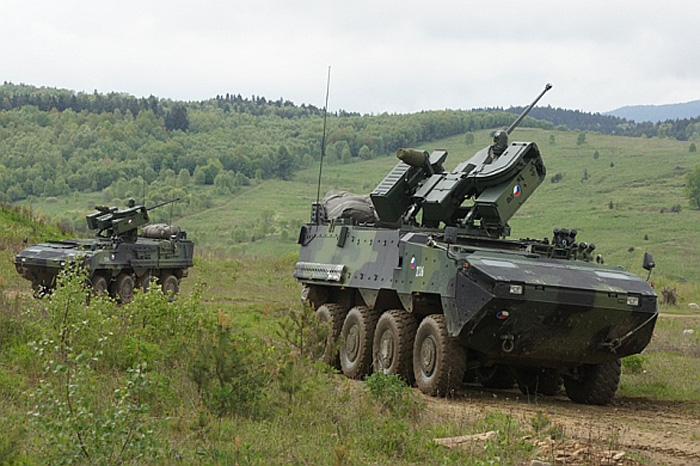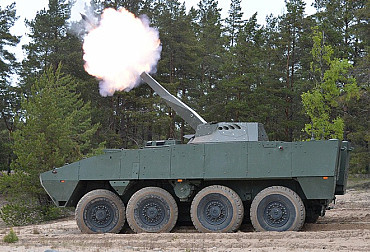Purchase of New Armoured Personnel Carriers 8x8 for the Slovak Army
At the end of April 2020, a press conference was held between the Minister of Defence of the Slovak Republic Jaroslav Naď and the Chief of the General Staff of the Armed Forces of the Slovak Republic Daniel Zmek, at which further progress in modernization projects of the Slovak Army was discussed. One of the key projects is also the purchase of new 8x8 armoured vehicles.
The proposal for the acquisition of new 8x8 armoured vehicles was submitted by former Minister of Defence Peter Gajdoš in 2017. The contract for the delivery of 8x8 vehicles was signed with the Finnish company Patria. According to former Minister of Defence Petr Gajdoš, up to 70 % of the value of the vehicle was to be produced in Slovakia. From then on, however, the project has been interlaced with problems and ambiguities.
At the press conference, the current Minister of Defence of the Slovak Republic, Jaroslav Naď, described the purchase of 8x8 armoured vehicles as a guide to non-transparency. What's more, the project is not in line with Slovakia's commitments to NATO, according to Jaroslav Naď. It was also for these reasons that the Minister of Defence decided not to continue the project for the time being.
Due to the ongoing crisis connected to the coronavirus pandemic, the project has not been much talked about for several months and its future is uncertain. In theory, it may happen that in an effort to maintain the transparency of the project, there will be a new selection procedure for new armoured vehicles. What types of armoured vehicles for the Slovak army would be possible in such a case? Below we present 3 platforms that could be interesting for Slovakia. Specifically, the armoured personnel carriers Pandur II 8x8, Boxer and Piranha 5.
Pandur II 8x8
The armoured personnel carrier Pandur II 8x8 is not unknown to Slovakia. Its modified version under the name Corsac 8x8 was presented by the Slovak company MSM Group (Slovak branch of the Czechoslovak Group holding) at the IDEB 2016 trade fair in Bratislava and later offered to the Slovak army in a tender for the purchase of new 8x8 armoured vehicles, in which the company competed with Finnish Patria.

Picture: In the 8x8 configuration, Pandur II vehicles are used in various versions in the Army of the Czech Republic (pictured), in Portugal, and recently Indonesia has joined the Pandur users. | army.cz
The Pandur II wheeled armoured personnel carrier was first introduced in 2001 by the American-Austrian company Steyr-Daimler-Puch, which in 2003 became part of the global General Dynamics Group. Pandur II vehicles in various versions are currently used in the Army of the Czech Republic, Portugal, and recently Indonesia has joined the Pandur II users.
From a technical point of view, it should be noted that the armoured vehicle Pandur II 8x8 is an amphibious vehicle. It can reach a speed of 105 km/h on land and in water it can float at a speed of 10 km/h. This interesting feature, enabling the Pandur II 8x8 to perform a wider range of tasks, was demanded by the Czech army, among other things, in the tender for wheeled vehicles in the first decade of this century.
An equally important parameter for armoured vehicles is their armament. In this area, the Pandur II 8x8 armoured vehicle has a sufficiently wide variability in the selection of turrets and cannons. The vehicle can be equipped with various types of weapons up to 105mm caliber, which serve as the primary weapon. The role of secondary armament can be performed by machine guns of various calibers, as well as anti-tank missiles SPIKE LR. The advantage of the Pandur II 8x8 armoured vehicles is their relatively low combat weight of 22 tons. The Corsac version offered to the Slovak army was even equipped with the Slovak Turra 30 turret.
From the point of view of the Slovak Republic, the Pandur II armoured vehicle is also interesting in terms of the possible involvement of domestic industry in their manufacturing. Thanks to the strategic partnership between the Czechoslovak Group (CSG) holding company and General Dynamics European Land Systems (GDELS), the Czech company Tatra Defence Vehicle (which is part of CSG) obtained a license not only to produce Pandur II 8x8 vehicles but also to sell them on selected markets, including Central Europe. Holding CSG also operates in Slovakia, through the aforementioned MSM Group. It has production and development capacities that are able to ensure the production of Pandur II armoured vehicles directly in Slovakia, which was demonstrated by the Corsac 8x8 vehicle. The involvement of the domestic defence industry would also have a positive effect on the Slovak economy. This is a fundamental factor which, together with the vision of compatibility with Slovakia's closest ally, the Czech Republic, is definitely worth reconsidering.
Boxer 8x8
The Boxer 8x8 armoured vehicle is manufactured by ARTEC GmbH, a joint venture of Krauss-Maffei Wegmann and Rheinmetall MAN Military Vehicles. Today, this vehicle is implemented in the armaments of the armies of Germany, the Netherlands, Lithuania and Australia, and in the coming years, there is the plan to implement Boxer vehicles into the armament of the Great Britain and Algeria. The Boxer 8x8 platform can attract potential interested parties with a wide range of add-on modules for various types of missions, which can be changed within a few tens of minutes according to the needs of the army.

Picture: Today, this vehicle is implemented in the armaments of the armies of Germany (pictured), the Netherlands, Lithuania and Australia, and in the coming years, there is the plan to implement Boxer vehicles into the armament of the Great Britain and Algeria. | Wikimedia Commons
Different versions of the Boxer 8x8 vehicles boast different equipment. The armoured personnel carrier versions can be equipped with remote-controlled stations with 7.62mm machine guns, the infantry fighting vehicle versions have LANCE and Samson Mk II turrets with medium-caliber cannons and there are also anti-tank guided missiles and grenade launchers. Another interesting feature of the Boxer 8x8 platform is the unusually high combat weight of the vehicle, ranging from 31.5 tons to 38.5 tons, depending on the specific versions. The high weight is mainly due to the degree of protection provided by the vehicle, which is one of the highest in its category. The Boxer 8x8 platform provides the highest protection in its class against heavy machine guns, medium-caliber automatic cannons, artillery shrapnel or cluster bombs. The high weight of the vehicle does not allow the vehicle to float, however, the engine with an output of up to 600 kW allows the vehicle to reach a speed of 103 km/h on the roads, thanks to which the Boxer can match the speed of lighter armoured vehicles.
From the point of view of Slovakia, it is important to say that more and more countries are interested in the Boxer vehicle. It is spoken of as one of the most successful armoured vehicles in the 8x8 category in the last 20 years. The Slovak Republic could thus use in their decision making the experience of countries which have already chosen the Boxer vehicle. With the eventual acquisition of the Boxer armoured vehicle, Slovakia could consider joining the BOXER Support Partnership group, which provides logistical support among users of Boxer vehicles. Germany, the Netherlands and Lithuania already belong to this group, and the United Kingdom also wants to become a member.
Piranha 5 8x8
The Piranha 5 is the fifth generation of the Piranha platform, manufactured by the Swiss company GDELS-Mowag (since 2010 the company has been a part of General Dynamics European Land Systems). The vehicle was presented for the first time at the Eurosatory exhibition in Paris in 2010. The Piranha 5 8x8 was originally designed for the British Army's FRES (Future Rapid Effect System) program.
Just like the Pandur II 8x8, the Piranha 5 armoured vehicle is amphibious. The development of the Piranha 5 vehicle utilized several decades of experience gained from combat missions which Piranha platform vehicles participated in. As a result, the vehicles have, for example, an increased level of protection compared to older versions of Piranha vehicles. The Piranha 5 can be equipped with an active protection system and additional armour, offering different levels of protection. Other elements of improved protection are also very interesting, such as integrated seats protecting the crew against mines or special shaped plates used for protection against explosions.

Picture: The parties interested in the latest generation of Piranha vehicles include Denmark, Romania and Spain. | GDELS / Public domain
In terms of armament, the Piranha 5 can be equipped with a wide range of weapons from 12.7mm machine guns, through medium-caliber rapid-fire cannons, to 105mm low-recoil cannons and various remote-controlled weapon stations and guided missiles. The Piranha 5 has improved mobility compared to older versions. The turning radius has been significantly reduced, which contributes to greater vehicle mobility, especially in confined spaces. Piranha 5 can also be equipped with hybrid propulsion systems.
As this is a new generation of armoured vehicle, it is difficult to evaluate its performance and especially customer satisfaction. On the other hand, older versions of Piranha vehicles are used by several armies around the world, which proves their reliability. The parties interested in the latest generation of Piranha vehicles include Denmark, Romania and Spain. In all three countries, the GDELS Group also involves local companies in the production of new vehicles, to which it transfers technology and production and assembly, similarly to the case of Pandur II vehicles in the Czech Republic. This fact could be an interesting opportunity for Slovakia to participate in the production of Piranha 5 vehicles and possibly in the further development of this machine.
In the article, we briefly introduced three possible armoured vehicles, each of which could be considered by the Slovak army. The fate of the acquisition of 8x8 armoured vehicles is still unclear, but it is appropriate to consider the scenario that the entire tender could be repeated again. In such a case, it would depend on the specific requirements of the Slovak army for new 8x8 armoured vehicles, and only on the basis of specifications could specific models of armoured vehicles be considered.





















